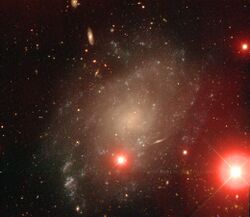Astronomy:NGC 45
| NGC 45 | |
|---|---|
 NGC 45 by DECam | |
| Observation data (2000.0 epoch) | |
| Constellation | Cetus |
| Right ascension | 00° 14′ 03.989″[1] |
| Declination | –23h 10m 55.53s[1] |
| Redshift | 0.001558[2] |
| Helio radial velocity | 466 km/s[3] |
| Distance | 21.7 Mly (6.64 Mpc)[4] |
| Apparent magnitude (V) | 10.73±0.03[5] |
| Apparent magnitude (B) | 11.21±0.03[5] |
| Characteristics | |
| Type | SA(s)dm[6] |
| Mass/Light ratio | [7] M☉/L☉ |
| Apparent size (V) | 7.41′ × 5.13' |
| Other designations | |
| MCG04-01-21, PGC 930[8] | |
NGC 45 is a low surface brightness[7] spiral galaxy in the equatorial constellation of Cetus. It was discovered on 11 November 1835 by the English astronomer John Herschel.[9] The galaxy is located at a distance of 22[4] million light years and is receding with a heliocentric radial velocity of 466 km/s.[3] It is located in the vicinity of the Sculptor Group, but is most likely a background galaxy.[7]
The morphological class of NGC 45 is SA(s)dm,[6] indicating this is a spiral galaxy with no prominent inner bar (SA) or ring (s) feature. There is no central bulge to speak of.[7] The galactic plane is inclined at an angle of 55°±5° to the line of sight from the Earth, with the major axis of the elliptical profile being aligned along a position angle of 145°±5°.[7] Star formation is proceeding at a modest rate of ~0.20 M☉·yr−1.[6]
Unlike the Milky Way, NGC 45 has no clearly defined spiral arms, and its center bar nucleus is also very small and distorted. NGC 45 thus does not have a galactic habitable zone.[10][11][12] For the Milky Way, the galactic habitable zone is commonly believed to be an annulus with an outer radius of about 10 kiloparsecs and an inner radius close to the Galactic Center, both of which lack hard boundaries.[11]
On 22 May 2018 a luminous red nova was detected within NGC 45 and was subsequently labeled AT 2018bwo.[13] Luminous red novae like this are thought to be the result of stars merging. The progenitor of AT 2018bwo was a yellow supergiant star.[14]
Gallery
Galex (ultraviolet) view of NGC 45
Hubble mosaic of NGC 45
References
- ↑ 1.0 1.1 Skrutskie, Michael F. et al. (1 February 2006). "The Two Micron All Sky Survey (2MASS)". The Astronomical Journal 131 (2): 1163–1183. doi:10.1086/498708. ISSN 0004-6256. Bibcode: 2006AJ....131.1163S.
- ↑ "NGC 0045". NASA NED. http://nedwww.ipac.caltech.edu/cgi-bin/nph-objsearch?objname=ngc+45&extend=no&hconst=73&omegam=0.27&omegav=0.73&corr_z=1&out_csys=Equatorial&out_equinox=J2000.0&obj_sort=RA+or+Longitude&of=pre_text&zv_breaker=30000.0&list_limit=5&img_stamp=YES.
- ↑ 3.0 3.1 Tully, R. Brent et al. (2016). "Cosmicflows-3". The Astronomical Journal 152 (2): 21. doi:10.3847/0004-6256/152/2/50. 50. Bibcode: 2016AJ....152...50T.
- ↑ 4.0 4.1 Karachentsev, Igor D. et al. (2016). "The Local Tully–Fisher Relation for Dwarf Galaxies". The Astronomical Journal 153 (1): 6. doi:10.3847/1538-3881/153/1/6. Bibcode: 2017AJ....153....6K.
- ↑ 5.0 5.1 Cook, David O. et al. (2014). "The Spitzer Local Volume Legacy (LVL) global optical photometry". Monthly Notices of the Royal Astronomical Society 445 (1): 881. doi:10.1093/mnras/stu1580. Bibcode: 2014MNRAS.445..881C.
- ↑ 6.0 6.1 6.2 Pannuti, Thomas G. et al. (September 2015). "Chandra and Very Large Array Observations of the Nearby Sd Galaxy NGC 45". The Astronomical Journal 150 (3): 16. doi:10.1088/0004-6256/150/3/91. 91. Bibcode: 2015AJ....150...91P. https://resolver.caltech.edu/CaltechAUTHORS:20151202-155013893.
- ↑ 7.0 7.1 7.2 7.3 7.4 Chemin, Laurent et al. (December 2006). "H I Studies of the Sculptor Group Galaxies. VIII. The Background Galaxies: NGC 24 and NGC 45". The Astronomical Journal 132 (6): 2527–2538. doi:10.1086/508859. Bibcode: 2006AJ....132.2527C.
- ↑ "NGC 45". SIMBAD. Centre de données astronomiques de Strasbourg. http://simbad.u-strasbg.fr/simbad/sim-basic?Ident=NGC+45.
- ↑ Seligman, Courtney. "NGC Objects: NGC 1 - 49". Celestial Atlas. https://cseligman.com/text/atlas/ngc0.htm.
- ↑ de Vaucouleurs, G.. "II. MORPHOLOGY, #34". Classification and Morphology of External Galaxies. https://ned.ipac.caltech.edu/level5/Dev/Dev5.html.
- ↑ 11.0 11.1 Gowanlock, M. G. et al. (2011). "A Model of Habitability Within the Milky Way Galaxy". Astrobiology 11 (9): 855–873. doi:10.1089/ast.2010.0555. PMID 22059554. Bibcode: 2011AsBio..11..855G.
- ↑ Choi, Charles Q. (21 August 2015). "Giant Galaxies May Be Better Cradles for Habitable Planets". Space.com. http://www.space.com/30335-giant-galaxies-habitable-planets.html.
- ↑ Transient Name Server entry for AT 2018bwo. Retrieved 10 November 2023.
- ↑ Blagorodnova, Nadejda et al. (2021). "The luminous red nova AT 2018bwo in NGC 45 and its binary yellow supergiant progenitor". Astronomy & Astrophysics 653: A134. doi:10.1051/0004-6361/202140525. Bibcode: 2021A&A...653A.134B.
External links
- Revised NGC Data for NGC 45
- NGC 45 on WikiSky: DSS2, SDSS, GALEX, IRAS, Hydrogen α, X-Ray, Astrophoto, Sky Map, Articles and images
Coordinates: ![]() 00h 14m 3.99s, −23° 10′ 55.5″
00h 14m 3.99s, −23° 10′ 55.5″
 |



